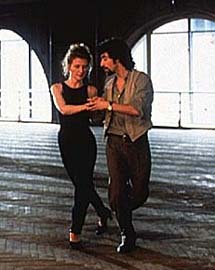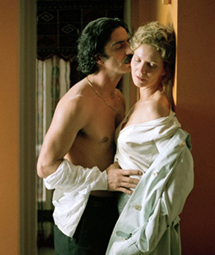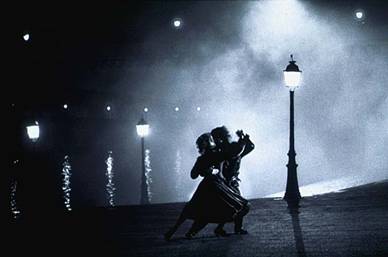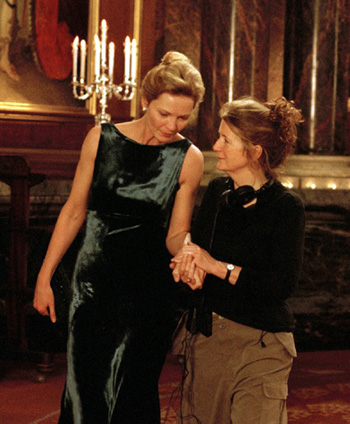|
Jan Chats
with
British Director Sally Potter

Sally Potter dancing with Pablo Verón in THE TANGO LESSON
Sally Potter’s new film YES, written in sensuous iambic pentameter, is the poetic complement to her much-loved film
THE TANGO LESSON. Jan recently met with Sally in Chicago to discuss identity, pride, passion, and the fine line between autobiography and self-examination.
Jan
The main characters in your new film YES
are played by Joan Allen (as “She”) and Simon Abkarian (as “He”). Did you deliberately create them as follow-up characters to the “Sally” character and the “Pablo” character in
THE TANGO LESSON? Is YES
the next stage in that relationship, so to speak?
|

Sally Potter & Pablo Verón
in THE TANGO LESSON
|

Joan Allen & Simon Abkarian
in YES |
Sally
You’re not the first person who’s said this to me. I’m now realizing, yeah.
Jan
Well, it seemed to me that there were so many parallels in the two relationships… Did I read that into
YES because I love THE TANGO
LESSON so much?
Sally
I always have the illusion I’m starting completely fresh and that each of my films has no resemblance whatsoever to anything else I’ve ever done before; I don’t like the idea of repeating myself. Nevertheless, certain things take awhile to work through and certain things are worthy of being looked at again, and I think one such thing is the dynamic of what happens with the professionally successful woman of the world in her personal relationships: what happens when a woman leads and a man needs to follow.
Jan
One common element is the fragile male ego. Both the Pablo Veron character in
THE TANGO LESSON and the Simon Abkarian character in
YES feel affronted, so in each case the woman character has to deal with wounded male pride.
Sally
Pride, for men, has a meaning that I think often women don’t understand. Sometimes it’s all they have left, their dignity and pride. So to rob a man of his pride is almost to rob him of himself, you know, rob him of himself.
Jan
The way you depict all of this is quite special, Sally. As a feminist, I’m very moved when you depict “submission.” For example, in
THE TANGO LESSON, Pablo tells Sally: “Just don’t do anything.” There’s a part of Sally that resists, but another part of her is very drawn to him when he asserts himself.
Sally
It’s part of becoming a complete human being; knowing when to take charge and be in control, and when to let go and surrender. Sometimes you follow, surrender; that’s not a lessening of yourself.
Jan
To hear these things said, in words, is like hearing fingernails scratching on a blackboard. But to see these complex emotions acted out in your films, well, they’re radiant: the dancing scenes, the love scenes…
Sally
We’re discussing very subtle areas in which one can easily, even in one’s own life, leap into cliché and misunderstand what the dynamic is. And historically, because women have been silenced, been the hidden ones, the followers, or whatever, it’s dangerous to feel like you’re going back there.

Sally & Pablo: They’ll always have Paris!
Jan
So how did you find the balance in your filmmaking such that a 52 year old feminist like me, who’s been married over 20 years, thinks that one of the most erotic movies she’s ever seen is
THE TANGO LESSON? How did you achieve that, Sally?
Sally
By taking a lot of dance lessons! It’s amazing to me that THE TANGO
LESSON is the film I get the most letters about. It’s eight years old now, that film, and two, three letters a day come in. It’s a long slow bond.
Jan
And what do people say to you in their letters?
Sally
They say THE TANGO LESSON changed their lives! I think maybe I’m not the best person to analyze it, but what people pick up on is the passion behind the film: the passion to make the film itself, the passion to dance again. At the age of 46 I put myself in a movie, dancing the Tango with the best tango dancer in the world… It was so terrifying, and so driven by passion at the same time, maybe that’s partly what people respond to.
But it’s also weird because it’s a very physical film, obviously, but it’s very cerebral and abstract too, and
THE TANGO LESSON recognizes the physical
dimensions of existence from the beginning.
Jan
And don’t forget funny! In the beginning, Sally’s whole house is falling down around her, and you show that in a very funny way, very self-mockingly. Are you revealing the “Sally” who is yourself, or is Sally someone else? She seems like a character.
Sally
She is a character. I used my life as the laboratory to research this character, and it became a form of true fiction. Sometimes you look through a photo album and you think: “Oh, I remember that.” But what you’re actually remembering is the photo of the experience. Now, when Pablo and I talk about
THE TANGO LESSON sometimes we can’t remember: Did it really happen, or did it happen in the film? And so memory and representation become forever intermingled.
Initially I thought of making it as a little documentary, but it grew. So to make it work dramatically, as a fiction, I had to subject it to the same rigors as I would any story. I had to write it as a story, and every line is written. I had to write Pablo’s lines, my lines, and so and so. Therefore, I can’t say that “Sally” was entirely “me,” because it’s a script.
Jan
Let’s take this back to YES
now, OK? In a way, you’ve recreated “Sally,” and this time you’re played by Joan Allen. What a thrill, huh?!?

Sally Potter (right) with Joan Allen (left)
her leading lady in YES.
Sally
I never thought of the character in YES
as “me” at all, but at the end of the shoot, Joan revealed that she had based some of her gestures and things on looking at me. I certainly never asked her to do that.
Jan
But she’s right, Sally. Joan Allen looks just enough like an idealized “you” for those of us who’ve seen
THE TANGO LESSON to carry forward the set of concerns that were “Sally’s,” and have now been reformulated in
YES.
Sally
The character in YES is many, many things that I’m not, really, but she is, of course, at the core of it all. She’s the character people seem to empathize with the most; something about the way she is, the way she’s written, and the ways Joan is performing what’s written.
Jan
Talk about the scene when she visits her aunt.
Sally
That is autobiographical, that sequence; it’s based on my experience of being with my grandmother when she was dying. It’s an eight page monologue from a character we’ve never met before, three quarters
of the way into the film. You can imagine how the financiers felt about it! They said: “You can’t do this, Sally.” I said: “You can; it’s my ‘Harry Lime’ moment!”
[Editor’s Note: Sir Carol Reed created one of the most memorable moments in film history when he made Orson
Welles (as “Harry Lime”) appear out of thin air near the end of
THE THIRD MAN. Meow!]
Jan
In YES, the Aunt’s dream was to go to Cuba. Why Cuba?
Sally
It’s a place that represents a dream. It’s an ideal, based on belief rather than on profit. And for the Auntie, it was her religion and a place she couldn’t go to, so she gives her niece her dying instructions. There’s only one Cuba. There’s only one place that’s holding out a different kind of economic system, and has that particular physical place in the world.
If you want an autobiographical note, I was 14 years old when the Cuban Missile crisis happened, and I was in my school uniform leafleting, trying to make sure that the world didn’t blow up. So maybe it was in my own psyche that it held that kind of place. I wanted to see, like the Auntie, how it turned out.

“He” & “She” visit Cuba in YES.
© Jan Lisa Huttner (6/23/05)
All stills courtesy of Sony Pictures Classics.
Photo credit for
THE TANGO LESSON: Moune Jamet.
Photo credit for YES: Nicola Dove.
Thanks to Sarah MarDock of SONY
& Jeff Marden of Hess Newmark Owens Wolf
for setting up this opportunity.
|
